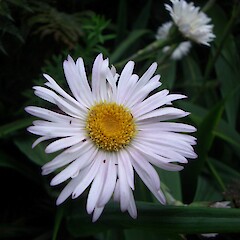Celmisia mackaui
Common name
Banks Peninsula daisy, Akaroa daisy
Synonyms
Celmisia coriacea Raoul auct. non Celmisia coriacea (G.Forst.) Hook.f.
Family
Asteraceae
Flora category
Vascular – Native
Endemic taxon
Yes
Endemic genus
No
Endemic family
No
Structural class
Herbs - Dicotyledonous composites
NVS code
The National Vegetation Survey (NVS) Databank is a physical archive and electronic databank containing records of over 94,000 vegetation survey plots - including data from over 19,000 permanent plots. NVS maintains a standard set of species code abbreviations that correspond to standard scientific plant names from the Ngä Tipu o Aotearoa - New Zealand Plants database.
CELMAC
Chromosome number
2n = 108
Current conservation status
The conservation status of all known New Zealand vascular plant taxa at the rank of species and below were reassessed in 2017 using the New Zealand Threat Classification System (NZTCS) – more information about this can be found on the NZTCS website. This report includes a statistical summary and brief notes on changes since 2012 and replaces all previous NZTCS lists for vascular plants.
Please note, threat classifications are often suggested by authors when publications fall between NZTCS assessment periods – an interim threat classification status has not been assessed by the NZTCS panel.
- Conservation status of New Zealand indigenous vascular plants, 2017 . 2018. Peter J. de Lange, Jeremy R. Rolfe, John W. Barkla, Shannel P. Courtney, Paul D. Champion, Leon R. Perrie, Sarah M. Beadel, Kerry A. Ford, Ilse Breitwieser, Ines Schönberger, Rowan Hindmarsh-Walls, Peter B. Heenan and Kate Ladley. Department of Conservation. Source: NZTCS and licensed by DOC for reuse under the Creative Commons Attribution 4.0 International licence.
2017 | At Risk – Naturally Uncommon | Qualifiers: OL
Previous conservation statuses
2012 | At Risk – Naturally Uncommon | Qualifiers: OL
2009 | At Risk – Naturally Uncommon
2004 | Range Restricted
Distribution
Endemic. South Island, Banks Peninsula only
Habitat
Coastal to montane: Usually found in damp, rocky places, especially along precipitous south-facing bluffs and waterfalls. Occasional extending into tussock grassland, and on sheltered rocky outcrops. Occasional found in seepages amongst Phormium.
Detailed description
Woody-based herb with short branchlets arising from a multicipital stock, usually just below the soil surface; living leaves in rosettes at the tips of branchlets; the whole plant forming a loose mat of numerous rosettes. Leaf sheaths densely imbricate, and compacted into a pseudostem. Leaf lamina 100-700 × 15-75 mm, somewhat flaccid, errect but tending to spread, lanceolate to narrow-elliptic; upper surface concolorous, bright to dark green, veins obvious; lower surface glabrous, glaucous green; tip acute; margins entire, often slightly recurved; base cuneate; petiole short, to 1/3 length of lamina, usually deep purple, glabrous or with scattered whitish hairs. Scape purple, up to 650 mm long; bracts numerous, erect, subulate, somewhat leafy; monocephalous. Capitula up to 50 mm diameter. Involucral bracts in several series, subulate, erect, glabrous. Ray florets 60-70, ligulate, the limb more or less linear, creamy white often tinged violet when capitulum first open. Disc florets c.200, funneliform, yellow; tube with eglandular biseriate hairs. Achene fusiform-cylindric, strongly ribbed, c.5 mm long, glabrous. Pappus unequal, c.7 mm long, of 55-60 bristles.
Similar taxa
Distinguished from all other Celmisia by the glaucous green leaf blade which is glabrous beneath. In this species the ray florets are usually pale violet in the bud stage and when first expanded, but fade to become white by anthesis.
Flowering
October - February
Flower colours
White, Yellow
Fruiting
December - May
Life cycle
Pappate cypselae are dispersed by wind (Thorsen et al., 2009).
Propagation technique
Easily grown from fresh seed. Celmisia mackauii is widely cultivated in many parts of New Zealand. It does best in a shaded, moist but free draining soil. Like most Celmisia it dislikes humidity and will not tolerate drying out.
Threats
A Naturally Uncommon narrow range endemic, that is locally widespread in the small part of Banks Peninsula from which it is known. Some populations are in decline as a natural conseqeunce of vegetation succession to taller forest, this species having temporarily expanded its range into habitats created by past logging, fires and attempts at farming.
Etymology
celmisia: Apparently named after Kelmis, one of Idaean Dactyls, a group of skilled mythical beings associated with the Mother Goddess Rhea in Greek mythology. Kelmis, whose name means ‘casting’, was a blacksmith and childhood friend of Zeus, son of Rhea and later king of the gods. In Ovid’s ‘Metamorphoses’, Kelmis is described as offending Zeus who turned him into adamant so he was as hard as a tempered blade
Where To Buy
Occasionally available from commercial nurseries.
Attribution
Description based on Given (1984)
References and further reading
Given, D.R. 1984: A taxonomic revision of Celmisia subgenus Pelliculatae section Petiolatae (Compositae—Astereae). New Zealand Journal of Botany 22: 139-158.
Thorsen, M. J.; Dickinson, K. J. M.; Seddon, P. J. 2009. Seed dispersal systems in the New Zealand flora. Perspectives in Plant Ecology, Evolution and Systematics 2009 Vol. 11 No. 4 pp. 285-309





